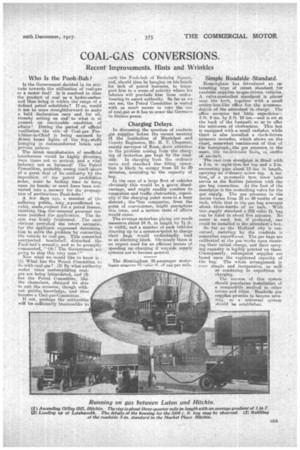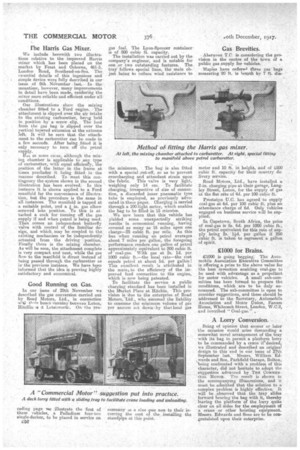COAL-GAS CONVERSIONS.
Page 21

Page 22

If you've noticed an error in this article please click here to report it so we can fix it.
Recent Improvements. Hints and Wrinkles
Who Is the Pooh-Bah?
Is the Government decided in its attitude towards the utilization of coal-gas as a motor fuel? Is it resolved to class the product of coal as a hydro-carbon and thus bring it -within the range of a defined petrol substitute? Esse, would it not be more straightforward to make a bald declaration once and for all, thereby setting an end to what is at present an intolerable condition of affairs? Doting the period of official vacillation the sole cif Coal-gas Prohibiter-in-Chief is being assumed by livers leaser lights of the big,. ataffs lounging in commandeered hotels and private palaces.
'The latest manifestation of unofficial interference would be highly diverting were times not so serious; and a vital industry not so haraese& The Petrol Committee, probably seeing itself 'shorn of a great deal of its authority by the imposition, of the petrol prohibition order, most be finding time . to hang upon its hands,' or must have beeu converted into a nursery for the propagation of pertinacious Pooh-bahs
• A f,ew days ago, a member of the suffering public,. long_apeonfirthed
roade,request for, a petrol lioenee, thinking thee, the•:unosual personal tea, sons. justified the application. The desire wa,s firmly frustrated. The snub obvious provoked the retort sarcastic, for the applicant expressed determination to solve the problem by converting the vehicle to coal-gas. This somewhat unexpected bombshell disturbed the Pooh-laah's serenity, and 80 he promptly commented, " Oh ! The Government are going to stop this very soon!" Now what we would like to know is (1) What has the Petrol -Committee to do with coal-gas? (2) By what authority motor users contemplating coalgas are being intimidated, and (3) has the -Petrol Committee, like the chameleon, changed itt skin to suit the occasion, though without public, knowledge and. tlina become a Coal-gan--Ctartmittee.
If not, perhaps the antliorities nit b sufficiently businesslike to
curb the Pooh-bah of Berkeley Square, and, should arne, be hanging on his hands for lack of petrol business, to transport him to a scene of activity where his labours will preclude him from endeavouring to assert authority. So far as we can see„ the Petrol Committee is vested with as much Dower to veto the use of coal-gas as it has to orner the Germans to declare peace.
Charging Delays.
In discussing the question of roadside , gas supplies before the 'recent meeting of the Institution of Municipal and County Engineers, Mr. H. T. Chapman, county surveyor of Kent,drew attention to the problem arising from 'the charging of motorbus gas bagS by the road
side. In charging from the ordinary main and. standard that filling operation is likely to occupy from 15 to 30 minutes', according. 'to the capacity of bag.
In the case of a large fleet of vehicles obviously this would be a grave disadvantage, and might readily conduce to congvstion -and traffic obstruction, especially if the charging point were,in a busy district; the 'bus companies, from the point of, convenience, might precipitate this issue, and a serious state of affairs -would ensue.
The average motorbus plying our roads measures. about 24 ft. in length by "(i ft. in width, and a niunber of such vehicles drawing up to a commoo.point to charge their bags would undoubtedly lead to an alarming block. Obvioualy there is an urgent need for an efficient 'means of speeding up -charging if wayside supply systems are. to become general.
The Birmingham 35-passenger motor buses aye-rave ^nhio ft. of ctas per mile.
Simple Roadside Standard.
Birmingham has iiitroduced an. interesting type of street standard for roadside supplies togas-driven vehic(es._ A valve-controlled stand-post is placed
Pear the kerb, together with a small sentry-box-like office for the accommodation of the attendant in charge. The office occupies but little soperficies 3 ft. 9 ins. by 2-ft. 10 ins.—and is set at the back of the footpath so as to offer the minimum of obstruction. This box is equipped with-a'small radiator, while there is also installed a clock-driven pressure recorder, which. shows on the chart, somewhat reminiscent of that of tthe banographri.the gas pressure in the man, the catmratogis btsin UInentli.s tif• ans. inch.
oast-iron staratiipt is fitted with a 2-in. vs. night-iron tee top and a 2-in. connecting pipe about 12 ins. in length, carrying an oodinary screw tap. A seeflan,. of a pteumatie tyre inner tube serves as the flexible junction with the gas bag Connection. At the foot of the atandpipe is the controlling valve for the gas supply. The gas pressure in the mains varies from 30 to 40 tenths of an inch, while thatin the gas bag averages about three-tenths of an inch. With this„supply standard a 250 cubic ft. bag can be fiked in about five minutes. No meter is used, but, if preferred, one could be installed in the attendant's box.
So far as the Midland city is COD earned, metering by the roadside is soinnhat superfluous. The gas bags are calibrated at, the as'works upon receiving their initial c.arge, and .their carrying eapacity is legibly printed.on them. Consequently, subsequent supplies • Ars based upon the registered capacity of the bag. The whole arrangement is very aimple and inexpensive, as well as conducing to expedition in charging.
The success of this system should popularise installation of a comparable method in other towns--and cities. Roadside gas sonpliee promise to become pressing, so a universal system should be establishes:.
• The Harris Gas Mixer.
We include herewith two illtntrations relative to the. improved Harris mixer which has been placed on the market by Feast and Osborne, 461-3, London Road, Southend-on-Sea. The essential details of this ingenious and simple device were fully described in our issue of 8th . November last. In the meantime, however, many improvements in detail have been made, rendering the mixer more reliable and efficient under all conditions'.
Our illustrations show the mixing chamber fitted to a Ford engine. = The attachment is slipped over the air intake to the existing carburetter, berig held in position by a screw clip. The feed from the gas bag is slipped over the vertical tapered extension at the extreme left. It will be seen that the attachment to the carburetter can be made in a few seconds. After being fitted it is only necessary to turn off the petrol supply. . .
ff in some cases, although the mixing chamber is applicable to any type of carburetter, with equal efficienry, the position of the latter in the frame at times precludes it being fitted in the manner described. To meet this contingency the system shown in the second illustration has been evolved: Li this instance it, is shown applied to a Ford manifold fig the convenience of illustration, but the procedure is the same in all instances. The manifold is tapped at a suitable point, and a Lin. gas elbow .screwed into position. To this is attached a cock for turning off the gas supply if and when petrol is being used. Then comes an independent butterfly valve with control of the familiar design, and which may be coupled to the existing mechanism or be independently actuated from • the driving position. Filially there is the mixing chamber. As will be seen, the attachment complete is very compact and neat, while the gas flow to the manifold is direct instead of being passed through the carburetter as in the, previous instance. We have been informed that the idea is proving highly satisfactory and economical.
Good Running on Gas.
In our issue of 29th November we described the gas conversion carried out by Road Motors, Ltd., in connection w4t1tb-ir buseS runnine, between Luton, Hitch-In •a ti LettirwortZ'. On the -pre
gas fuel. The Lyon-Spencer container. is of -500 cubic ft. capacity.
The installation was carried out by the company's engineer, and is notable for one or two outstanding features. The tray follows special lines, themain object being to reduce wind resistance to
the minimum. The bag is. also fitted with a special cut-off, so as to prevent overcharging and attendant strain upon
the fabric. This valve is very light, weighing only 14 ozs. To facilitate charging, irrespective of size of COTHIce-arm, a discarded inner, pneumatic tyre tube is employed, as previously advocated in these pages. Charging is carried through a 100-light meter, which enables the bag to be filled in 15 minutes. We now learn that this vehicle has yielded some unexpectedly striking results in economical running, having covered as many as 16 miles upon one charge-25 cubic ft. per mile. As this bus when running on petrol averages about 7 miles per gallon, the foregoing performance renders one gallon of petrol approximately equivalent to 200 cubic ft. of coal-gas. With gas at 2s. ld. per 1000 cubic ft.—the local rate—the cost equals petrol at about 51 per gallon! This excellent result is attributed in the main‘ to the efficiency of the improved feed connection to the engine, which is now being patented.
To facilitate the service a public charging standard has been installed in the Market Place at Hitchin. This provision is due to the enterprise of Road Motors, Ltd, who assumed the liability to consume the minimum volume of gas per annum xit down'-by tholocal gas
Gas Brevities.
Aberavon T.0 is considering the provision in the centre of the town of a public gas supply for vehicles. .
Maples have ordered three gas bags measuring 20 ft. in lew.th by 7 ft. dia.
meter and 10 ft. iii height, and of 1500 cubic ft. capacity for their country delivery service.
Road Motors, Ltd., have installed a 2-in, charging pipe at their garage, Langley Street, Luton, for the supply of gas at the flat rate of 4d. per 100 cubic ft. .
Pcestatyn U.C. has agreed to supply coal-gas at 6d. per 100 cubic ft. plus an attendance charge of 6d. Only vehicles engaged on business service will be supplied.
In Capetown, South Africa, the price of coal-gas is 8s. 6d. per 1000 cubic ft., the petrol equivalent for this rate of supply being 2s. 1id. per gallon ii 250 cubic ftis taken to represent Et, gallon of spirit.
£1000 for Brains.
£1000 is going begging. The Automobile Association Executive Committee is offering a prize to the above value for the hest invention enabling coal-gas to be used with advantage as a propellant
for motor vehicles. A small sub-committee h-as been formed to prepare the conditions, which are to be duly announced. The sub-committee is open to consider suggestions, and these should be addressed to the 8ecretary, Automobile Association and Motor Union, Fanunt House, Whitcomb Street, London, W.C.2, and inscribed " Coal-gas." ,
A Lorry Conversion.
Being of opinion that sooner or later the occasion would arise demanding a somewhat novel arrangement of the tray with its bag to permit a platform lorry to be commanded by a crane'ir desired, we illustrated and described an original design to this end in our issue of 27th September last. Messrs. William Ed\wards and Son, Parkfield Garage, Bolton, 'being confronted with a problem of this character, did not hesitate to adopt the suggestion advanced by THE COMMERCIAL IldOTOlt. The result is shown in the accompanying illustrations, and it must be admitted that the solution to a' complex problem is highly effective. It will be observed that the tray slides forward bearing the bag with it, thereby leaving the platform of the lorry quite clear On all sides for the employment of a crane or other hoisting equipment. Messrs. Edwards and Sons are to be congratulated upon their enterprise.
























